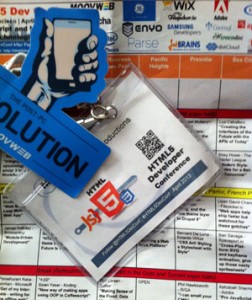
Look to your right. See those conference listings? They all sound great -- fun, informative, valuable. They also sound expensive. By the time you add up the conference, tutorials, travel costs, hotel and missing work, you’re easily out a few thousand dollars. Is it really worth it?  The answer, of course, is: “It depends.” Whether you’re spending your own time and effort or making a case for your boss, here are some tools you need to make sure that you’re using conferences effectively.
The answer, of course, is: “It depends.” Whether you’re spending your own time and effort or making a case for your boss, here are some tools you need to make sure that you’re using conferences effectively.
Types of Conferences
There are many different types of conferences. They vary in size, scope, target audience, price, duration and location. Most are good for somebody, but they may not be right for you.
Large Technology Presentation
These are usually put on by an industry association or a large company. They’re basically a big showcase for the sponsor’s new features and initiatives. The focus here is on keeping up to date with the newest, neatest stuff. For the conference sponsor, it’s a big marketing opportunity and a chance to get fans all excited about what’s coming up. Think of these as large community-building events. They tend to be light on specific learning or opportunities for newbies, and very much geared toward showing changes to people who are already savvy about the industry or technology stack.
- Size: Hundreds to thousands of attendees.
- Scope: Usually show off new things -- technology, techniques, devices, etc.
- Target Audience: People who already know the technology and are looking for updates and to get excited about the community again.
- Price: A few thousand dollars, with additional cost for tutorials.
- Examples: Apple’s World Wide Developer Conference, CES, Java One, DreamForce.
Peer Conferences or Unconferences
These are specifically designed to facilitate members of a community – testers or Ruby on Rails engineers, for example -- coming together to learn from each other. They tend to be light on sessions and formal training, but include more workshops and “hallway time” where rooms are available for unstructured discussion. A peer conference will usually be targeted at professionals in a given technology, industry or focus area, such as “beginning ruby engineers,” “startup founders” or “women actuaries.”
- Size: Small. A few dozen to a few hundred attendees.
- Scope: Usually show off new things -- technology, techniques, devices, etc.
- Target Audience: Peers - usually working professionals at the mid- to senior level.
- Price: In the mid-hundred dollar range.
- Examples: Conference for the Association of Software Testing (CAST), Burlington Ruby Conference, Mass TLC Innovation unConference.
Training Conferences
These conferences are intense training sessions around a technology or set of technologies. They’re often put on by training or education companies, and sometimes result in a certification or completion certificate. They fall into two categories: survey courses that provide an introduction to technologies, or narrowly scoped that teach to great depth. The survey courses are intended for people new to the technology or industry. The in-depth events are usually targeted to those who have a good grounding in the basics and want to start specializing.
- Size: Varies. Some for a few dozen attendees, others up to about 1000 people.
- Scope: Training, and sometimes testing.
- Target Audience: Students and learners.
- Price: Generally expensive -- hundreds or thousands of dollars per day.
- Examples: TechEd, Static Analysis Symposium.
Research Conferences
These are about presenting and discussing research and/or academic findings in a particular area. They tend to focus on the evaluation of techniques and science more than specific implementations or descriptions of techniques. Proceedings center on the presentation and discussion of papers and analysis. They’re frequently international.
- Size: Varies. Usually a few hundred attendees, although the large ones can be a thousand people or a bit more.
- Target Audience: Researchers, academics, and specialists.
- Price: Mid-hundreds.
- Examples: International Conference on Software Maintenance, Tools and Algorithms for Construction and Analysis of Systems, Object-Oriented Programming Systems, Languages, and Applications (OOPSLA).
What Do You Want?
The first step to evaluating a conference is understanding what you want to get from it. Are you looking to learn a new technology? Do you want to keep up to date on new features and products in your area of expertise or market space? Are you looking to make a name for yourself? Do you want to spend time just talking with peers from other companies who might have to solve the same problems you do? This need will drive a lot of the value you get from a conference. For example, a large industry-wide event is probably not a great place to have hours of discussions with your peers. The following questions are useful guides to evaluate a conference:
- Am I willing to travel? If so, driving distance, flying distance or internationally?
- How long can I take for this conference on a weekday? On a weekend?
- What is my budget?
- Do I want to learn, teach or discuss?
- Am I seeking a certification or other concrete outcome?
- Am I most concerned about gaining new skills, honing existing skills or pushing the envelope of my field?
Will This Conference Give Me What I Want?
Based on your answers, it’s easy to eliminate conferences that are too far away, too long or too expensive. In addition, you can cross off any types of conferences that don’t match your goals. If you want to get some training in a new technology, for example, you can eliminate research and large technology presentation conferences. If your goal is to stay at the forefront of your field, you can skip training conferences but should strongly consider peer events or research conferences. From there, winnowing down conferences sinks into the details. For each conference you’re considering, dig deep into the schedule. Consider the following:
- What are the track sessions? Do they line up with your goals? Do they look too easy? Too esoteric? Not useful for your day job? Do you find yourself exclaiming, “that’s what I need!” repeatedly?
- Who are the speakers? Look in particular at speaker bios. Some conferences are full of people from one company or industry group. This often indicates an event that’s mostly about pushing that company’s agenda (for better or for worse). Other conferences will feature a lot of consultants and independent contractors. This is fairly normal, but is usually a sign of a peer or training conference with a survey outlook. For technology-oriented conferences, look for the big names -- committers to the core technology, for example.
- Past output: This is particularly important for research conferences, where the point is to create works that are usable and ripe for citation. Most conferences publish proceedings, such as speaker decks or recordings of sessions. Read the proceedings and watch the sessions. Session titles can be misleading. All of this material can show you whether the sessions are at your level.
- Who else is going? Check mailing lists and social media. Who do you respect that’s going? What peers of yours are considering or attending? If no one’s going, that’s probably a sign. If everyone you know is going, that’s an indication the conference is worth considering.
Ultimately, deciding if a conference is good for you is about deciding whether it meets your needs, your availability and your budget. Evaluate carefully, and then go confer.

